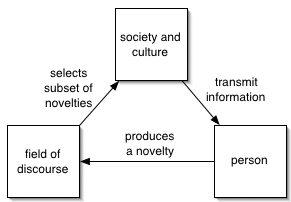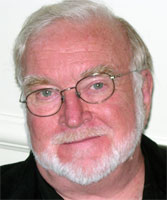
 When I
first learned
that
Mihaly Csikszentmihalyi
(whose name is pronounced 'me-HI chick-SENT-me-hi')
would be speaking here, I hoped that he might be able
to help me to understand better the role of
flow in learning
and programming. These ideas have been on mind
occasionally through experience with the Suzuki
method of piano instruction and Alan Kay's comments
on the same in his
talks at OOPSLA.
When I left the lecture room last night, I was a
bit disappointed with the talk, but as time passes
I find that its ideas have me thinking...
Csikszentmihalyi opened by explaining that his
interest creativity began as a child in Hungary.
Many of his family members were artists and lived
rich lives, but most people he knew lived "fragile
lives", all too sensitive to the vagaries of war
and economy. He chose to study creative people
to see how everyone can live a better life, a less
fragile life, a beautiful life.
Through his studies, he came to distinguish "small
c" creativity and "big C" Creativity. To some
degree, we all are creative in the small-c way,
doing things that enrich our own lives but do not
receive recognition from the outside world. Big-c
creativity is different -- it produces ideas that
"push our species ahead". At first, the use of
recognition to distinguish quality of creativity
seemed incongruent, but I soon realized that
creative ideas take on a different form when they
move out into the world and mingle with the rest
of a domain's knowledge and culture. Csikszentmihalyi
came back to this nugget later in his talk.
Big-C creativity is rare. Defining it is impossible,
because every definition seems to over- or
underconstrain something essential to creativity
from our own experience. But Csikszentmihalyi
asserted that society values Creativity for its
ability to transform people and cultures, and
that it drives creative people to "pursue to completion"
the creative act.
To support his claim of scarcity and to begin to
expose the culture's role in recognizing creativity,
Csikszentmihalyi presented some empirical studies
on the relationship between individuals' contributions
and their disciplines. The first was the so-called
Lotka Curve.
Alfred Lotka
was an eminent biophysicist of the early 1900s. In
the mid-1920s, he identified a pattern of publication
in scientific journals. Roughly 60% of all people
who publish publish only one journal article. The
percentage of people who publish two articles is much
smaller, and the percentage of people who publish
more articles falls rapidly as the number of articles
increases. This creates an L-shaped graph of the
function mapping number of publications onto the
percentage of contributors at that level.
The second was Price's Law. He referred not to
the law from physics, which describes a model of
gravitational collapse and the "strong cosmic
censorship conjecture" (a great name!), but to
another model of contribution: one-half of all
contributions in any domain are made by the
square root of all potential contributors.
According to Csikszentmihalyi, Price derived
his law from data in a large variety of domains.
I do not have citations to refereed publications
on either of these models, so I'm at the speaker's
mercy as to their accuracy. The implication is
substantial: in any group, most people contribute
little or nothing to the group. Perhaps that is
stated too strongly as a generalization, because
a single publication or a single piece of art
can make a major contribution to the world, belying
the creator's point on the Lotka Curve. But if
these models mean what Csikszentmihalyi claims,
culture and even narrower domains of discourse
are driven forward by the work of only a few.
I don't think that this will alarm too many people.
It sounds just like the
long tail
and
power law
that dominates discussion of the web and social
networks these days.
Finally Csikszentmihalyi got around to describing
his own results. Foremost was this model of how
creativity and ideas affect the world:
When I
first learned
that
Mihaly Csikszentmihalyi
(whose name is pronounced 'me-HI chick-SENT-me-hi')
would be speaking here, I hoped that he might be able
to help me to understand better the role of
flow in learning
and programming. These ideas have been on mind
occasionally through experience with the Suzuki
method of piano instruction and Alan Kay's comments
on the same in his
talks at OOPSLA.
When I left the lecture room last night, I was a
bit disappointed with the talk, but as time passes
I find that its ideas have me thinking...
Csikszentmihalyi opened by explaining that his
interest creativity began as a child in Hungary.
Many of his family members were artists and lived
rich lives, but most people he knew lived "fragile
lives", all too sensitive to the vagaries of war
and economy. He chose to study creative people
to see how everyone can live a better life, a less
fragile life, a beautiful life.
Through his studies, he came to distinguish "small
c" creativity and "big C" Creativity. To some
degree, we all are creative in the small-c way,
doing things that enrich our own lives but do not
receive recognition from the outside world. Big-c
creativity is different -- it produces ideas that
"push our species ahead". At first, the use of
recognition to distinguish quality of creativity
seemed incongruent, but I soon realized that
creative ideas take on a different form when they
move out into the world and mingle with the rest
of a domain's knowledge and culture. Csikszentmihalyi
came back to this nugget later in his talk.
Big-C creativity is rare. Defining it is impossible,
because every definition seems to over- or
underconstrain something essential to creativity
from our own experience. But Csikszentmihalyi
asserted that society values Creativity for its
ability to transform people and cultures, and
that it drives creative people to "pursue to completion"
the creative act.
To support his claim of scarcity and to begin to
expose the culture's role in recognizing creativity,
Csikszentmihalyi presented some empirical studies
on the relationship between individuals' contributions
and their disciplines. The first was the so-called
Lotka Curve.
Alfred Lotka
was an eminent biophysicist of the early 1900s. In
the mid-1920s, he identified a pattern of publication
in scientific journals. Roughly 60% of all people
who publish publish only one journal article. The
percentage of people who publish two articles is much
smaller, and the percentage of people who publish
more articles falls rapidly as the number of articles
increases. This creates an L-shaped graph of the
function mapping number of publications onto the
percentage of contributors at that level.
The second was Price's Law. He referred not to
the law from physics, which describes a model of
gravitational collapse and the "strong cosmic
censorship conjecture" (a great name!), but to
another model of contribution: one-half of all
contributions in any domain are made by the
square root of all potential contributors.
According to Csikszentmihalyi, Price derived
his law from data in a large variety of domains.
I do not have citations to refereed publications
on either of these models, so I'm at the speaker's
mercy as to their accuracy. The implication is
substantial: in any group, most people contribute
little or nothing to the group. Perhaps that is
stated too strongly as a generalization, because
a single publication or a single piece of art
can make a major contribution to the world, belying
the creator's point on the Lotka Curve. But if
these models mean what Csikszentmihalyi claims,
culture and even narrower domains of discourse
are driven forward by the work of only a few.
I don't think that this will alarm too many people.
It sounds just like the
long tail
and
power law
that dominates discussion of the web and social
networks these days.
Finally Csikszentmihalyi got around to describing
his own results. Foremost was this model of how
creativity and ideas affect the world:

The idea is to be so ... so saturated with it that there's no future or past, it's just an extended present in which you're, uh, making meaning. And dismantling meaning, and remaking it.I'm guessing that every programmer hears that quote and smiles. We know the feeling--saturation, making meaning. Csikszentmihalyi closed his talk with a couple of short remarks. The most interesting was to refute the common perception that Creative people are prone to living dissolute lives. On the contrary, the majority of the folks he has studied and interviewed have been married for all of their adult lives, have families, participate at their churches in in civic organizations. They have somehow come to balance "real life" with sustained episodes of flow. But, true to Personality Trait #10 on the list above, they all feel guilty about not having spent more time with their spouses and children! (At this point, I had to leave the talk just as the question-and-answer session was beginning. I had to pick my daughters up from play rehearsal. :-) This talk has led me to a few thoughts...
And, to the extent that we can stimulate an environment in which the creative moment can occur, you need to active, engaged, and aware. That is a major component of the success that we see in highly productive people.